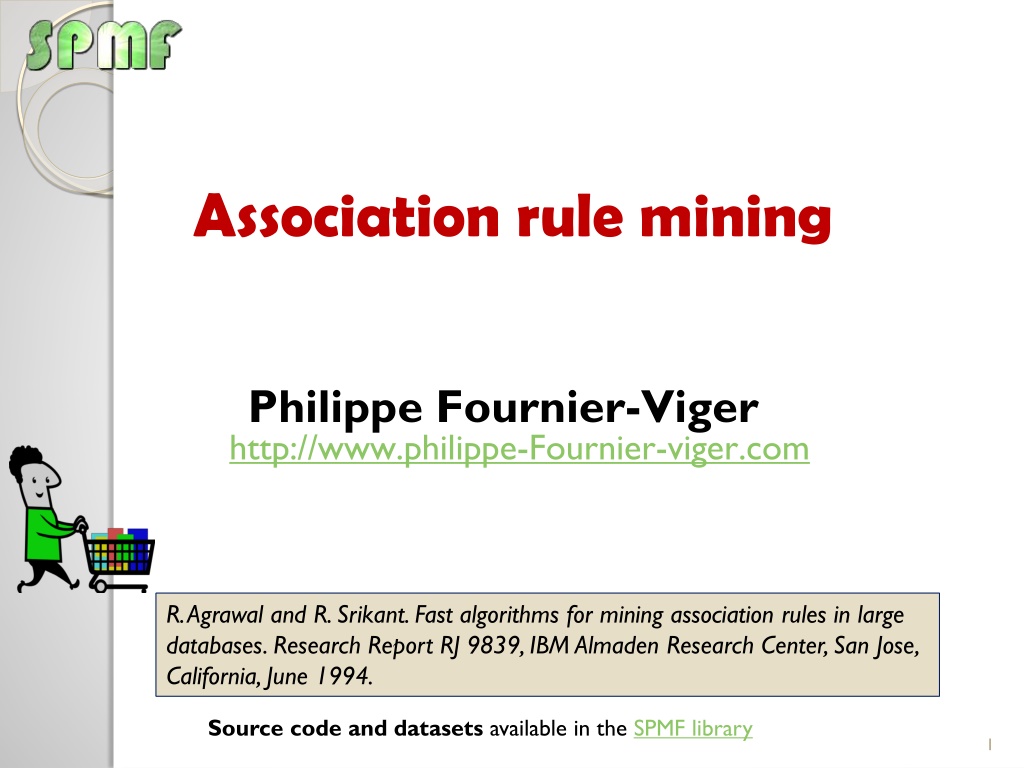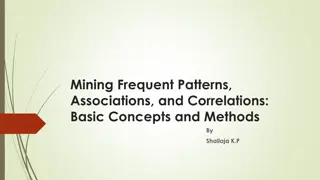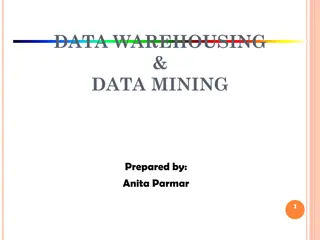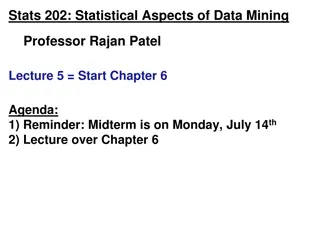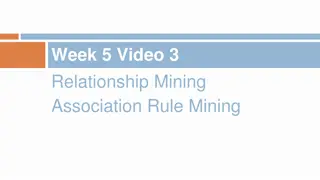Understanding Association Rule Mining in Data Analysis
Association rule mining is a data analysis technique introduced by Agrawal & Srikant in 1994, focusing on discovering interesting associations between values in a dataset. This involves finding frequent itemsets, infrequent itemsets, and utilizing properties to reduce the search space. The goal is to unveil patterns like products frequently bought together, enhancing decision-making processes based on data insights.
Download Presentation

Please find below an Image/Link to download the presentation.
The content on the website is provided AS IS for your information and personal use only. It may not be sold, licensed, or shared on other websites without obtaining consent from the author. Download presentation by click this link. If you encounter any issues during the download, it is possible that the publisher has removed the file from their server.
E N D
Presentation Transcript
Association rule mining Philippe Fournier-Viger http://www.philippe-Fournier-viger.com R. Agrawal and R. Srikant.Fast algorithms for mining association rules in large databases. Research Report RJ 9839, IBM Almaden Research Center, San Jose, California, June 1994. Source code and datasets available in the SPMF library 1
Association rule mining A data analysis task proposed by Agrawal & Srikant (1994) Goal: find interesting associations between values in a dataset. E.g. discover the products that people like to purchase together frequently In this video, I will explain association rule mining and the relationship with itemset mining 2
ITEMSET MINING (BRIEF REVIEW) 3
Frequent itemset mining () A transaction database: Transaction Items appearing in the transaction T1 T2 T3 {pasta, lemon, bread, orange} {pasta, lemon} {pasta, orange, cake} T4 {pasta, lemon, orange cake} For minsup= 2, the frequent itemsets are: {lemon}, {pasta}, {orange}, {cake}, {lemon, pasta}, {lemon, orange}, {pasta, orange}, {pasta, cake}, {orange, cake}, {lemon, pasta, orange} 4
minsup =2 l p b o c frequent itemsets lb lo lc pb lp po pc bo bc oc pbc poc boc lpb lpo lpc lbo lbc loc pbo l = lemon p = pasta b = bread 0 = orange c = cake Infrequent itemsets lpbo lboc lpbc lpoc pboc lpboc 5
Property 2: Let there be an itemset Y. If there exists an itemset X Y such that X is infrequent, then Y is infrequent. Example: Consider {bread, lemon}. If we know that {bread} is infrequent, then we can infer that {bread, lemon} is also infrequent. Transaction Items appearing in the transaction T1 T2 T3 {pasta, lemon, bread, orange} {pasta, lemon} {pasta, orange, cake} T4 {pasta, lemon, orange, cake} 6
This property is useful to reduce the search space. Example: If bread is infrequent minsup =2 l p b o c lb lo lc pb lp po pc bo bc oc pbc poc boc lpb lpo lpc lbo lbc loc pbo lpbo lboc lpbc lpoc pboc lpboc 7
This property is useful to reduce the search space. Example: If bread is infrequent, all its supersets are infrequent. minsup =2 l p b o c lb lo lc pb lp po pc bo bc oc pbc poc boc lpb lpo lpc lbo lbc loc pbo lpbo lboc lpbc lpoc pboc lpboc 8
ASSOCIATION RULE MINING ( ) 9
Introduction Finding frequent patterns in a database allows to find useful information. But it has some limitations 10
Introduction A transactional database D Transaction T1 T2 T3 T4 Items in the transaction {pasta, lemon, bread, orange} {pasta, lemon} {pasta, orange, cake} {pasta, lemon, orange, cake} If minsup = 2, then {pasta, cake} is frequent. Can we conclude that people who buy pasta will also buy cakes? 11
Association rule An association rule is a rule of the form ? ? where X and Y are itemsets, and ? ? = . e.g. {orange, cake} {pasta} {lemon,orange} {pasta} {pasta} {bread}
Support The support of a rule ? ? is calculated as sup(? ?) = sup(???)/ |D| where |D| is the number of transactions. Transaction T1 T2 T3 T4 Items in the transaction {pasta, lemon, bread, orange} {pasta, lemon} {pasta, orange, cake} {pasta, lemon, orange, cake} e.g. {lemon, orange} {pasta} has a support of 0.5 i.e. two out of four transactions. 13
Confidence The confidence of a rule ? ? is calculated as conf(? ?) = sup(???)/ sup(?)|. Transaction T1 T2 T3 T4 Items in the transaction {pasta, lemon, bread, orange} {pasta, lemon} {pasta, orange, cake} {pasta, lemon, orange, cake} {lemon, orange} {pasta} has a confidence of 1.0 (100%) 14
Confidence The confidence of a rule ? ? is calculated as conf(? ?) = sup(???)/ sup(?)|. Transaction T1 T2 T3 T4 Items in the transaction {pasta, lemon, bread, orange} {pasta, lemon} {pasta, orange, cake} {pasta, lemon, orange, cake} {pasta} {lemon} has a confidence of 0.75 {lemon} {pasta} has a confidence of 1.0 15
Association rule mining Input: A transaction database (set of transactions) A parameter minsup A parameter minconf (0 ?????? 1) (0 ??????? 1) Output: each association rule ? ? such that: sup ? ? ?????? and conf ? ? ??????? {pasta} {lemon} has a confidence of 0.75 {lemon} {pasta} has a confidence of 1.0 16
Example minsup = 0.5 minconf = 0.75 Transaction T1 T2 T3 T4 Items in the transaction {pasta, lemon, bread, orange} {pasta, lemon} {pasta, orange, cake} {pasta, lemon, orange, cake} lemon pasta pasta lemon orange pasta pasta orange cake pasta cake orange lemon orange pasta orange cake pasta pasta cake orange cake pasta orange support: 3 support: 3 support: 3 support: 3 support: 2 support: 2 support: 2 support: 2 support: 2 support: 2 confidence: 1 confidence: 0,75 confidence: 1 confidence: 0,75 confidence: 1 confidence: 1 confidence: 1 confidence: 1 confidence: 1 confidence: 1 17
Why using the support and confidence? The support allows to: find patterns that are less likely to be random. reduce the number of patterns, make the algorithms more efficient. The confidence allows to: measure the strength of associations obtain an estimation of the conditional probability P( Y | X ). Warning: a strong association does not mean that there is causality!
How to find the association rules? Na ve approach 1. Create all association rules. 2. Calculate their confidence and support by scanning the database. 3. Keep only the valid rules. This approach is inefficient. For d items, there are: possible rules. For d =6, this means 602 rules! For d =100, this means 1047rules!
Observation 1 Transaction T1 T2 T3 T4 Items in the transaction {pasta, lemon, bread, orange} {pasta, lemon} {pasta, orange, cake} {pasta, lemon, orange, cake} lemon pasta pasta lemon orange pasta pasta orange support: 3 support: 3 support: 3 support: 3 confidence: 1 confidence: 0,75 confidence: 1 confidence: 0,75 Observation 1. All the rules containing the same items can be viewed as having been derived from a same frequent itemset. e.g. {pasta, lemon} 20
Observation 2 Transaction T1 T2 T3 T4 Items in the transaction {pasta, lemon, bread, orange} {pasta, lemon} {pasta, orange, cake} {pasta, lemon, orange, cake} lemon pasta pasta lemon orange pasta pasta orange support: 3 support: 3 support: 3 support: 3 confidence: 1 confidence: 0,75 confidence: 1 confidence: 0,75 Observation 2. All the rules containing the same items have the same support, but may not have the same confidence. e.g. {pasta, lemon} 21
Observation 3 Transaction T1 T2 T3 T4 Items in the transaction {pasta, lemon, bread, orange} {pasta, lemon} {pasta, orange, cake} {pasta, lemon, orange, cake} lemon pasta pasta lemon orange pasta pasta orange support: 3 support: 3 support: 3 support: 3 confidence: 1 confidence: 0,75 confidence: 1 confidence: 0,75 Observation 3. If an itemset is infrequent, all rules derived from that itemset can be ignored. e.g. If minsup = 4 , rules derived from {pasta, lemon} can be ignored, since its support is 3. 22
How to find association rules eficiently? Aggrawal & Srikant (1993). Two steps: 1. Discover the frequent itemsets. 2. Use the frequent itemsets to generate association rules having a confidence greater or equal to minconf. Step 1 is the most difficult. Thus, most studies are on improving the efficiency of Step 1.
Generating rules Each frequent itemset Y of size k can produce 2k-2 rules. A rule can be created by dividing an itemset Y in two non empty subsets to obtain a rule ? ? ?. Then, the confidence of the rule must be calculated.
Generating rules Example: using the itemset X={a, b, c}, we can generate: ?,? ? ?,? ? ?,? ? ? ?,? ? ?,? ? ?,?
Calculating the confidence Example: using the itemset X={a, b, c}, we can generate: ?,? ? ?,? ? ?,? ? ? ?,? ? ?,? ? ?,? How can we calculate the confidence of rules derived from X? We must know the support of all subsets of X. We know it already, since if X is a frequent itemset, then all its subsets are frequent!
Calculating the confidence The result of a frequent itemset mining program looks like this: {pasta} {lemon} {orange} {cake} support = 4 support = 3 support = 3 support = 2 {pasta, lemon} {pasta, orange} {pasta, cake} {lemon, orange} {orange, cake} support: 3 support: 3 support: 2 support: 2 support: 2 {pasta, lemon, orange} {pasta, orange, cake} support: 2 support: 2 How can we quickly search for the support of a set? 27
Calculating the confidence Solution 1: Itemsets are grouped by size, Itemsets having the same size are sorted by some total order . binary search {pasta, lemon} {pasta, orange} {pasta, cake} {lemon, orange} {orange, cake} support: 3 support: 3 support: 2 support: 2 support: 2 pasta lemon bread orange cake 28
Calculating the confidence Solution 2: itemsets are stored in a trie to search for itemsets in O(1) time lemo n:3 cake:2 orange:3 pasta:4 lemo n:3 orange:3 cake:2 cake:2 orange:2 This path in the tree represents the itemset {pasta} which has a support of 4 orange:2 cake:2 29
Calculating the confidence Solution 2: itemsets are stored in a trie to search for itemsets in O(1) time lemo n:3 cake:2 orange:3 pasta:4 lemo n:3 orange:3 cake:2 cake:2 orange:2 This path in the tree represents the itemset {pasta, orange} which has a support of 3 orange:2 cake:2 30
Calculating the confidence Solution 2: itemsets are stored in a trie to search for itemsets in O(1) time lemo n:3 cake:2 orange:3 pasta:4 lemo n:3 orange:3 cake:2 cake:2 orange:2 This path in the tree represents the itemset {pasta, orange, cake} which has a support of 2 orange:2 cake:2 31
Reducing the search space Can we reduce the search space using the confidence measure? Confidence is not an anti-monotone measure. However, the following relationship between two rules can be proved: Theorem: If a rule ? ? ?does not satisfy the confidence threshold, any rule ? ? ? such that ? ?will also not satisfy the confidence threshold.
Proof Let there be two rules ? ? ?and ? ? ? such that ? ?. The confidence of these rules are conf(? ? ?) = sup(???) sup(?) sup(? ) conf(? ? ? ) = sup(???) Since ? ?, it follows that sup(? ) sup ? . Thus: conf(? ? ? ) conf(? ? ?) and the theorem holds. 33
Illustration Low-confidence rule These rules can be eliminated
Generating rules le plus grand itemset dans A enlever X de A where F is the set of all frequent itemsets A is the set of all proper non empty subsets of F
EVALUATING ASSOCIATIONS
Evaluating associations A large amount of patterns can be discovered How to find the most interesting patterns? Interestingness measures: objective measures: statistical reasons for selecting patterns subjectives: discover surprising or interesting patterns (e.g. diaper beer is more surprising than mouse keyboard). It is more difficult to consider subjective measures in the search for patterns.
Objective measure Independent from any domain e.g.support and confidence Several objective measures can be calculated using a contingency table. e.g. a table with 2 binary attributes ? ? ? ?11 ?10 ?1+ ?00 ?0+ ? ?01 ?+1 ?+0 ?
Limitations of the support and confidence If we use the minsup threshold, we will find less results, it will be faster, but we may eliminate some rare patterns that are interesting.
Another problem Consider: {tea} {coffee} support : 15% confidence : 75 % This seems like an interesting pattern ?????? ?????? ??? 150 50 200 800 ??? 650 150 conf(? ?) = sup ? ? sup(?) 800 200 1000 However, 80 % of the people drink coffee no matter if they drink tea or not. In fact, the probability of drinking coffee for tea drinkers is lower than for non tea drinkers (80 instead of 75 %)! This problem occurs because the confidence measure does not consider the support of the left side of rules.
The lift sup(? ?) sup(?) sup(?) lift(? ?) = conf(? ?) = sup(?) if = 1, X and Y are independent if > 1, X and Y are positively correlated if < 1, X and Y are negatively correlated Example: lift({tea} {coffee}) = 0.9375, This indicates a slightly negative correlation
Limitations of the lift Example: ? ? ? ? ? 880 50 930 ? 20 50 70 ? 50 70 20 ? 50 930 880 930 70 1000 70 930 1000 lift({?} {?}) =1.02 even if they appear together in 88 % of the transactions lift({?} {?}) = 4.08 even if they rarely appear together. In this case, using the confidence provides better results: conf({?} {?}) = 94.6 % conf({?} {?}) = 28.6 %
Many other measures Tan and al. (2004) Many measures They have different properties. e.g. symetrical, anti- monotonic, etc.
References Some content from these sources: Data Mining: The Textbook by Aggarwal (2015) Data Mining and Analysis Fundamental Concepts and Algorithms by Zaki & Meira (2014) Han and Kamber (2011), Data Mining: Concepts and Techniques, 3rd edition, Morgan Kaufmann Publishers, Tan, Steinbach & Kumar (2006), Introduction to Data Mining, Pearson education, ISBN-10: 0321321367. 44
